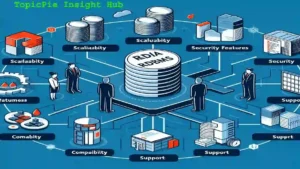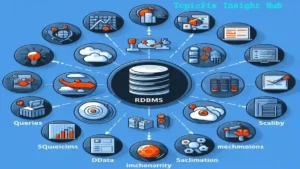Welcome to the digital era, where data reigns supreme and efficient management is key. In this fast-paced world of information overload, businesses and organizations are constantly seeking innovative solutions to handle their ever-growing data needs. Enter RDBMS – the revolutionary technology that is reshaping the way we manage and interact with data in the 21st century. Join us on a journey as we unravel the power of RDBMS technology and discover how it is revolutionizing data management in the digital age.
In today’s digital era, businesses worldwide rely heavily on data, making efficient and reliable data management solutions more critical than ever. This is where RDBMS technology steps in to revolutionize the way organizations handle their valuable information.
RDBMS, short for Relational Database Management System, offers a structured approach to storing and retrieving data. By organizing information into tables with rows and columns, RDBMS ensures data integrity and facilitates easy access to relevant data points.
Gone are the days of sifting through endless spreadsheets or dealing with inconsistent data formats – RDBMS streamlines database operations and enhances overall productivity. With features like SQL constraints, database normalization, and robust transaction management capabilities, RDBMS empowers users to make informed decisions based on accurate and up-to-date information.
As businesses continue to navigate the complexities of modern-day data challenges, RDBMS technology stands as a beacon of efficiency and reliability in an ever-evolving digital landscape.
Understanding RDBMS Concepts:
Understanding RDBMS concepts is essential in the digital age to effectively manage data. RDBMS stands for Relational Database Management System, which organizes data into structured tables.
Each table consists of rows (records) and columns (fields), where each field represents a specific attribute of the data. A NULL value indicates missing or unknown information within a field.
SQL constraints ensure data integrity by enforcing rules like unique key constraints or foreign key relationships between tables. Database normalization helps eliminate redundancy and inconsistencies in the database design.
By grasping these fundamental RDBMS concepts, users can navigate and manipulate large datasets efficiently. It sets the foundation for utilizing advanced features and functionalities offered by relational databases like MySQL to optimize data storage and retrieval processes.
What is RDBMS?
RDBMS stands for Relational Database Management System. It is a software system designed to manage and store data based on the relational model, which organizes data into tables with rows and columns. This type of database management system uses Structured Query Language (SQL) as its standard interface for accessing and managing data.
Also Read: The Benefits of Using Google Merchant Center with Shopify for E-commerce Success
In RDBMS, data is structured in a way that allows relationships between different datasets to be defined, making it easier to retrieve and manipulate information efficiently. Each table in an RDBMS represents an entity or object, while each row contains the specific instances of that entity.
The ability of RDBMS to handle complex queries across multiple tables sets it apart from traditional flat-file databases. By using keys and constraints, RDBMS ensures data integrity by enforcing rules on how data can be manipulated within the database system.
What is a Table?
In the realm of relational database management systems (RDBMS), a table is a fundamental concept that plays a crucial role in organizing and storing data. Think of it as a structured way to represent information, similar to how you would organize data in a spreadsheet. Each table consists of rows and columns, where each row represents an individual record or entry, while each column corresponds to a specific attribute or field.
Tables provide a clear structure for storing related data points together, making it easier to query and retrieve information when needed. It helps maintain consistency and integrity within the database by defining the type of data that can be stored in each column. Additionally, tables enable relationships between different sets of data through keys and constraints, allowing for efficient retrieval and manipulation of interconnected information.
Understanding how tables work is essential for designing well-organized databases that optimize storage efficiency and facilitate seamless data management processes within RDBMS technology.
What is a Field?
In the realm of relational database management systems (RDBMS), a field is an essential concept that plays a crucial role in organizing and storing data. Think of it as a single piece of information within a record or row, representing a specific attribute or characteristic.
Fields are used to define the structure of a table, indicating what type of data can be stored in each column. For instance, in an employee table, fields could include employee ID, name, position, salary, and hire date.
Each field has its own set of properties such as data type (text, number), length (maximum characters), and whether it allows NULL values. These properties help ensure data integrity and consistency within the database.
Understanding fields is fundamental for designing efficient databases that can store and retrieve information accurately based on predefined criteria.
What is a Record or a Row?
In the realm of relational database management systems (RDBMS), a record or row is a fundamental concept that plays a crucial role in organizing and storing data efficiently.
A record represents a single instance or entry in a table, containing specific information related to an entity. Think of it as a horizontal arrangement where each field holds different attributes about the same subject.
When you visualize a spreadsheet, each row corresponds to a unique record with distinct data values across various columns. This structure allows for easy access and retrieval of specific details within the database.
Whether it’s customer information, inventory items, or financial transactions, records help maintain order and coherence in managing extensive datasets effectively. Understanding how records function is essential for optimizing data storage and retrieval processes within RDBMS environments.

What is a Column?
In the context of relational databases, a column can be thought of as a vertical arrangement of data within a table. Each column represents a specific attribute or characteristic related to the entities being stored in the database.
Columns are defined with a specific data type that dictates what kind of information can be stored in them. For example, columns can store numerical values, text strings, dates, or even binary data like images.
Having well-defined columns is crucial for organizing and categorizing data efficiently. It allows for easy retrieval and manipulation of information when executing queries against the database.
In essence, columns play a fundamental role in structuring the database schema and ensuring consistency and accuracy in storing and retrieving data. They help maintain order within tables by specifying what type of information each part of the table should contain.
What is a NULL Value?
In the world of RDBMS, a NULL value represents the absence of data in a field. It indicates that the value is unknown or not applicable. When a field allows NULL values, it means that it can be left empty when inserting a new record into the database.
NULL values are distinct from empty strings or zero values. They serve as placeholders and can affect how calculations and comparisons are performed in queries. It’s essential to handle NULL values correctly to prevent unexpected results in data analysis.
Dealing with NULL values requires careful consideration during database design and query writing. Understanding how to properly manage them can help maintain data integrity and ensure accurate reporting.
As you navigate through managing databases, grasping the concept of NULL values will enable you to make informed decisions when working with relational databases like MySQL.
SQL Constraints
SQL Constraints represent regulations imposed on the data columns within a table to maintain integrity and enforce rules. They ensure the accuracy and reliability of the data stored in a database.
One common type of constraint is the “NOT NULL” constraint, which restricts a column from having any NULL values. This helps maintain data integrity by requiring all entries to have a valid value.
Another essential constraint is the “UNIQUE” constraint, which ensures that all values in a column are unique and do not repeat. This is often used for primary key fields to uniquely identify each record in a table.
The “PRIMARY KEY” constraint ensures that each record in a table is uniquely identified by containing only distinct values. It enforces entity integrity by acting as an identifier for each row.
Additionally, the “FOREIGN KEY” constraint establishes relationships between tables by linking the key field of one table to another’s key field.
SQL Constraints play a crucial role in maintaining the consistency and accuracy of relational databases.
Data Integrity
Data integrity is a crucial aspect of any relational database management system. It refers to the accuracy, consistency, and reliability of data stored in the database. Maintaining data integrity ensures that the information remains valid and reliable throughout its lifecycle.
One way to enforce data integrity is through constraints like unique constraints, foreign key constraints, and check constraints. Unique constraints ensure that each record in a table is distinct, while foreign key constraints maintain referential integrity between tables. Check constraints allow you to define specific rules for acceptable values in a column.
Also Read: Intraday Trading Mastery: Crafting Your Winning Plan for Profit
By implementing these mechanisms, RDBMS technology helps organizations uphold the quality and reliability of their data. This results in better decision-making processes based on accurate information available within the database system.
Database Normalization
Database normalization is a crucial concept in RDBMS technology. It’s all about organizing data efficiently to reduce redundancy and dependency. By breaking down data into smaller, manageable parts, normalization ensures that each table contains unique and related information only.
The main goal of normalization is to eliminate any anomalies that could affect data integrity. This process involves dividing large tables into smaller ones and establishing relationships between them through keys like primary and foreign keys.
Through normalization, databases become more flexible, scalable, and easier to maintain over time. It minimizes redundant data storage while avoiding issues like update anomalies that can occur when modifying records in a denormalized database structure.
Understanding the principles of database normalization is key to designing robust relational databases that can effectively store and retrieve data for various applications seamlessly.
Exploring MySQL RDBMS:
Are you ready to dive into the world of MySQL RDBMS? Let’s explore this popular relational database management system that has been revolutionizing data management in the digital age.
MySQL is a powerful RDBMS that is known for its reliability, ease of use, and scalability. Whether you are a beginner or an experienced developer, there are plenty of resources available to help you master MySQL.
From tutorials to SQL examples, MySQL provides a robust platform for storing and managing your data efficiently. With features like transactions and stored procedures, MySQL offers flexibility and control over your databases.
Understanding what a relational database is essential when working with MySQL. By grasping the concept of tables, fields, records (or rows), columns, keys, and constraints – you’ll be better equipped to leverage the full potential of MySQL in your projects.
So go ahead and start exploring MySQL RDBMS today!
MySQL Tutorial
Are you new to MySQL and eager to learn the basics? A MySQL tutorial is an excellent starting point. It typically covers essential topics like setting up a database, creating tables, inserting data, querying information using SQL commands, and more. By following step-by-step instructions in a MySQL tutorial, you can quickly grasp the fundamentals of this powerful RDBMS.
Many tutorials also include practice exercises to reinforce your learning and enhance your skills. You may find tutorials tailored for beginners or advanced users depending on your level of expertise. Whether you’re interested in managing databases for personal projects or professional purposes, mastering MySQL through a well-structured tutorial can be immensely beneficial.
Additionally, video tutorials are becoming increasingly popular as they offer a dynamic way to engage with the material visually. So if you prefer visual demonstrations over text-based guides, exploring video MySQL tutorials could be advantageous for your learning journey.
MySQL SQL
MySQL SQL, or Structured Query Language, is the language used to communicate with a MySQL database. It allows users to interact with the database by querying, updating, and managing data within it.
SQL statements in MySQL are powerful tools that can retrieve specific data from tables using commands like SELECT, INSERT, UPDATE, and DELETE. These statements enable users to filter information based on certain criteria and perform various operations on the database.
In MySQL SQL queries are written following a specific syntax that must be adhered to for successful execution. Understanding how to construct these queries is essential for effectively managing data within a MySQL database.
By mastering MySQL SQL commands, users can tailor their interactions with the database according to their needs. This enables efficient manipulation of data and ensures accurate retrieval of information when required.
MySQL Database
When it comes to databases, MySQL stands out as one of the most popular choices for businesses and developers alike. The MySQL database is a relational database management system that allows users to store and manage their data efficiently.
MySQL databases are known for their reliability, scalability, and ease of use. Businesses rely on MySQL to handle large volumes of data while ensuring quick access and retrieval when needed.
With its robust features like ACID compliance, transactions support, and stored procedures, MySQL provides a secure environment for managing critical business information.
Furthermore, MySQL databases are compatible with various operating systems such as Windows, Linux, macOS, making it versatile across different platforms.
The MySQL database continues to revolutionize data management in the digital age by offering powerful solutions for storing and processing vast amounts of information effectively.
MySQL Examples
Are you looking to understand how MySQL works in real-life scenarios? Let’s delve into some practical examples that showcase the power of this popular RDBMS.
In an e-commerce website, MySQL can be used to store customer information like names, addresses, and purchase history. This data can then be efficiently retrieved for personalized marketing campaigns or order processing.
For a social media platform, MySQL can manage user profiles, posts, comments, and likes. By leveraging the relational structure of MySQL tables, relationships between users and their interactions can be easily maintained and analyzed.
In the healthcare industry, MySQL databases can store patient records securely while allowing authorized medical professionals to access crucial information quickly. This ensures efficient treatment processes while maintaining data confidentiality within regulatory standards.
These examples highlight just a few ways in which MySQL is utilized across different industries to streamline operations and enhance data management practices.
What is a Relational Database?
A relational database is a type of database that organizes data into tables containing rows and columns. These tables establish relationships between the data, allowing for efficient storage and retrieval of information.
In a relational database, different tables can be linked through common fields, enabling complex queries to be executed seamlessly. This structure helps in reducing data redundancy and ensures data integrity.
The concept of normalization plays a crucial role in relational databases by organizing data efficiently to minimize duplication and dependency issues. Normalization helps in maintaining consistency within the database.
Relational databases follow the ACID properties (Atomicity, Consistency, Isolation, Durability), ensuring transactions are processed reliably without any compromise on data integrity. This makes them suitable for handling critical business applications where accuracy is paramount.
The Evolution of Relational Databases:

Since their inception, relational databases have made significant advancements. The history of relational databases dates back to the 1970s when Edgar F. Codd introduced the concept of organizing data into tables with rows and columns. This revolutionary idea paved the way for efficient data management in the digital age.
The core of the relational model lies in establishing relationships between different tables using keys like primary keys and foreign keys. These relationships ensure data integrity and promote better organization of information within a database system. Transactions and stored procedures further enhance the functionality by allowing developers to execute multiple operations as a single unit.
Database constraints play a crucial role in maintaining data consistency, while normalization helps reduce redundancy and improve overall database efficiency. With advancements in technology, distributed relational databases have emerged, enabling organizations to scale their operations seamlessly across multiple locations or servers.
History of Relational Databases
The inception of relational databases traces its roots to the 1970s, marking the beginning of a substantial historical journey. Edgar F. Codd, an English computer scientist employed at IBM, initially introduced the concept. His groundbreaking research laid the foundation for what would become known as the relational model of data management.
Codd’s ideas revolutionized how data could be stored and accessed, leading to the development of Structured Query Language (SQL) as a standardized way to interact with relational databases efficiently and effectively.
Over time, companies like Oracle, Microsoft, and MySQL further refined and popularized relational database technology, making it a cornerstone in modern data management systems across various industries.
The evolution of relational databases has been marked by continuous innovation and improvement, adapting to meet the growing demands of businesses in an increasingly digital world.
Relational Model
The relational model is the foundation of RDBMS technology, organizing data into tables with rows and columns.
Each table represents an entity, such as customers or products, while each row contains specific data instances related to that entity.
Columns in a table define the attributes or characteristics of the entity, like name or age.
Keys play a crucial role in establishing relationships between tables by uniquely identifying records within a table.
Primary keys ensure each row’s uniqueness, while foreign keys establish links between different tables for efficient data retrieval.
Understanding the relational model helps developers design databases that are structured and optimized for querying and analyzing vast amounts of information efficiently.
Keys in RDBMS
Keys in RDBMS play a crucial role in ensuring data integrity and maintaining relationships between different tables.
In relational databases, keys are used to uniquely identify each record within a table. A Primary Key, either a single column or a combination of columns, serves to uniquely identify each row within a table, thereby preventing the existence of duplicate records.
Foreign Keys establish relationships between tables by linking the Primary Key of one table to a Foreign Key in another table. This enforces referential integrity, ensuring that related data is consistent across tables.
Also Read: Top Strategies for Effective Working Capital Management
Unique Keys ensure that values in a column or group of columns are unique across all rows in the table, except for NULL values. They prevent duplicate entries but allow multiple NULL values.
Composite Keys consist of two or more columns which together uniquely identify rows in a table. They offer flexibility when one column alone cannot guarantee uniqueness.
Transactions and Stored Procedures
Transactions and stored procedures are essential components of RDBMS technology.
A transaction ensures that all operations within it are treated as a single unit, either fully completed or fully rolled back in case of failure. This helps maintain data integrity by avoiding partial updates.
On the other hand, stored procedures are precompiled SQL statements stored in the database for frequent use. Improving both performance and security, they achieve this by minimizing network traffic and thwarting SQL injection attacks.
By using transactions with multiple queries or executing complex logic through stored procedures, users can ensure consistency in their data operations.
Moreover, transactions help manage concurrency control by locking resources during data manipulation to prevent conflicts between concurrent users accessing the same data simultaneously.
Mastering transactions and utilizing well-designed stored procedures can significantly improve the efficiency and reliability of your relational database management system.
Database Constraints
Database constraints are rules that enforce data integrity within a relational database management system (RDBMS). These constraints ensure the accuracy and reliability of the data stored in tables. One common type of constraint is the primary key, which uniquely identifies each record in a table. This helps prevent duplicate entries and ensures data consistency.
Another important constraint is the foreign key, which establishes a relationship between two tables. It enforces referential integrity by ensuring that values in one table match with values in another. Check constraints are used to limit the range of values that can be inserted into a column, providing additional control over the data being entered.
Constraints play a vital role in maintaining data quality and enforcing business rules within an RDBMS environment. By defining these limitations at the database level, organizations can safeguard their information assets and support efficient operations.
Database Normalization
Database normalization is a crucial concept in the realm of relational database management systems. It involves organizing data to reduce redundancy and improve data integrity. By breaking down large tables into smaller, related tables, normalization minimizes duplication of information.
There are different levels of normalization, from first normal form (1NF) to Boyce-Codd Normal Form (BCNF), each focusing on specific rules for structuring data efficiently. Through this process, redundant data is eliminated, ensuring consistency and accuracy within the database.
Normalization also simplifies queries and updates by streamlining the process of retrieving and modifying data across multiple tables. This results in improved performance and maintainability of the overall database system.
Understanding and implementing proper normalization techniques is essential for creating well-structured databases that support efficient data management and retrieval processes.
Distributed Relational Databases
Distributed relational databases are a game-changer in the digital age, allowing data to be spread across multiple locations. This technology enhances scalability and improves fault tolerance by distributing data processing tasks among different servers or nodes. By decentralizing storage and computation, distributed relational databases can handle vast amounts of data more efficiently.
In a distributed setup, data is replicated on several servers to ensure redundancy and availability in case of failures. This architecture also enables faster access to information as requests can be processed concurrently by multiple nodes. Additionally, distributed relational databases support geographical distribution, making it easier to cater to global user bases while maintaining performance levels.
Implementing a distributed relational database requires careful planning and consideration of factors such as network latency, consistency models, and partitioning strategies. With the right approach, organizations can leverage the power of distributed systems to achieve high availability and reliability for their critical business applications.
Unraveling the Power of RDBMS:

RDBMS technology has transformed the way data is managed in the digital age. Understanding the power of RDBMS is essential for anyone dealing with data on a regular basis.
RDBMS stands for Relational Database Management System, which organizes data into tables consisting of rows and columns. SQL (Structured Query Language) is used to interact with RDBMS databases efficiently.
The features of RDBMS include ACID properties – Atomicity, Consistency, Isolation, and Durability. These ensure that transactions are processed reliably while maintaining data integrity.
One key advantage of RDBMS is its ability to establish relationships between different tables through keys such as primary keys and foreign keys. This allows for efficient querying and retrieval of related information across multiple tables.
Popular uses of RDBMS include managing customer information in CRM systems, processing financial transactions in banking applications, and storing inventory data in e-commerce platforms. The versatility and reliability of RDBMS make it a valuable tool in various industries worldwide.
RDBMS vs. DBMS
When it comes to managing data, understanding the difference between RDBMS and DBMS is crucial. Relational Database Management Systems (RDBMS) are built on a relational model that organizes data into tables with rows and columns. This structured approach allows for efficient storage and retrieval of information.
On the other hand, Database Management Systems (DBMS) refer to a broader category that includes various types of databases, not limited to relational ones. While both systems handle data management tasks, RDBMS specifically enforces relationships between tables using keys like primary and foreign keys.
RDBMS offers more robust features such as ACID properties for transaction management, ensuring data integrity and consistency. These systems also support complex queries through SQL for seamless data manipulation processes. Understanding these distinctions can help businesses choose the right database solution tailored to their needs.
Features of RDBMS
RDBMS, or Relational Database Management System, offers a wide array of features that make it an indispensable tool in modern data management. One key feature is its ability to store and retrieve data efficiently using structured query language (SQL). This allows for easy manipulation of data through predefined functions and commands.
Another important feature of RDBMS is its support for ACID properties – Atomicity, Consistency, Isolation, and Durability. These properties ensure that database transactions are processed reliably and securely. Additionally, RDBMS provides robust security mechanisms to control access to databases and protect sensitive information from unauthorized users.
Scalability is yet another notable feature of RDBMS systems. They can easily handle large volumes of data without compromising performance. Moreover, RDBMS supports the normalization process to eliminate redundancy in data storage, ensuring efficient use of disk space.
How RDBMS Works
How RDBMS works is a fascinating topic that delves into the inner workings of relational database management systems. At its core, RDBMS organizes data into tables with rows and columns, allowing for efficient storage and retrieval of information.
When a user executes a query using SQL (Structured Query Language), the RDBMS engine processes the request by analyzing the relationships between different tables based on predefined schemas. This process involves optimizing queries for speed and accuracy to deliver results promptly.
RDBMS leverages various algorithms like indexing and caching to enhance performance when handling large datasets. Additionally, it ensures data integrity through ACID properties (Atomicity, Consistency, Isolation, Durability) to maintain accurate and reliable information storage.
Understanding how RDBMS works provides insights into its efficiency in managing complex data structures while ensuring consistency and reliability in digital environments.
Advantages of RDBMS
In the digital age, RDBMS technology offers numerous advantages for efficient data management. One key benefit is data integrity, ensuring accuracy and consistency throughout the database. This helps in maintaining high-quality information.
RDBMS allows for easy database normalization, organizing data into logical structures while reducing redundancy. This leads to improved efficiency and saves storage space. Additionally, RDBMS supports complex queries through SQL, enabling users to extract valuable insights from large datasets quickly.
Another advantage of RDBMS is its ability to enforce constraints that maintain the reliability of the data stored within tables. These constraints help in preventing errors or inconsistencies in the database.
Moreover, with features like transactions and stored procedures, RDBMS ensures data security and provides mechanisms for controlling access rights for different users. These advantages make RDBMS a powerful tool for businesses looking to streamline their data management processes efficiently.
Popular Uses of RDBMS
In the digital age, RDBMS technology has found widespread use across various industries. One of the popular applications of RDBMS is in e-commerce platforms where it efficiently manages large volumes of customer data, product information, and sales transactions.
Moreover, RDBMS is extensively utilized in the banking sector for handling sensitive financial data securely and ensuring regulatory compliance. The healthcare industry benefits from RDBMS by organizing patient records, medical histories, and treatment plans effectively.
You may also like to read: Choosing a Right Marketing Automation Platform for your Business: Essential Factors to Consider
Additionally, government agencies leverage RDBMS to store citizen information securely and streamline administrative processes. Educational institutions utilize RDBMS for managing student records, course schedules, and academic performance data efficiently.
The versatility of relational database management systems makes them invaluable tools for organizations looking to organize and manage their data effectively in today’s fast-paced digital landscape.
Choosing and Managing RDBMS:
When it comes to choosing and managing RDBMS, there are several key factors to consider. One important aspect is understanding the types of relationships that can exist between tables in a relational database. These relationships help maintain data integrity and ensure efficient querying of information.
Key features of RDBMS include the ability to enforce data constraints using SQL constraints, ensuring that data input meets specific criteria. Additionally, RDBMS systems provide transaction management capabilities allowing for the execution of multiple operations as a single unit.
Advantages and disadvantages should also be weighed when selecting an RDBMS for your organization’s needs. While these systems offer robust data management solutions, they may have limitations depending on the scale and complexity of your data requirements.
Popular RDBMS options in 2023 include MySQL, PostgreSQL, Oracle Database, Microsoft SQL Server among others. Selecting the right relational database involves evaluating factors like scalability, security features, licensing costs as well as community support available for troubleshooting.
Database management tools play a crucial role in efficiently administering an RDBMS system by providing functionalities such as monitoring performance metrics, automating backups and managing user access permissions effectively. All-in-one solutions for RDBMS management streamline tasks related to database administration making it easier for organizations to leverage the power of their relational databases seamlessly.
Types of Relationships
When it comes to RDBMS, understanding the types of relationships is key in designing effective databases. The most common relationships are one-to-one, one-to-many, and many-to-many.
In a one-to-one relationship, each record in Table A corresponds to only one record in Table B and vice versa. This type of relationship is useful when information can be separated logically.
A one-to-many relationship exists when a single record in Table A can relate to multiple records in Table B. In this scenario, a single customer can place multiple orders, yet each order is associated exclusively with one customer.
Many-to-many relationships occur when multiple records in both tables can be related to each other. To implement this type of relationship, an intermediary table linking both main tables is necessary.
Understanding these relational patterns helps streamline data management processes efficiently within RDBMS systems.
Key Features of RDBMS
In the realm of relational database management systems (RDBMS), several key features set them apart from traditional database management systems. One fundamental feature is the ability to establish relationships between different tables, enabling efficient data retrieval and manipulation.
Another essential feature of RDBMS is data integrity through constraints like primary keys, foreign keys, and unique constraints that maintain the accuracy and consistency of data within the database. This ensures that only valid and meaningful information is stored.
Furthermore, transactions in RDBMS allow for atomicity, consistency, isolation, and durability (ACID properties), ensuring reliability in handling complex operations. Stored procedures provide a way to encapsulate frequently used tasks for efficiency and security purposes.
Database normalization plays a crucial role by organizing data into well-structured relations without redundancy or anomalies. This process enhances data integrity while optimizing storage space utilization within the database system.
Advantages and Disadvantages
Advantages of using RDBMS technology are numerous. One key benefit is data consistency, ensuring that information remains accurate across all tables. Another advantage is the ability to enforce data integrity through constraints like unique keys and foreign keys.
RDBMS also offers scalability, allowing businesses to easily expand their databases as needed without compromising performance. Additionally, RDBMS systems support transactions, ensuring that complex operations either fully succeed or fail together.
On the downside, one disadvantage of RDBMS can be the cost associated with setting up and maintaining these systems. Moreover, for extremely large datasets or highly unstructured data, RDBMS may not always be the most efficient solution compared to other database technologies like NoSQL databases.
While RDBMS technology brings significant advantages in terms of data management and reliability, it’s essential for organizations to weigh these benefits against potential drawbacks before implementing a relational database system.
Popular RDBMS in 2023
When it comes to popular RDBMS in 2023, a few key players continue to dominate the market. MySQL remains a top choice for many businesses due to its reliability and scalability. With an open-source nature, MySQL is also cost-effective, making it appealing for startups and small enterprises.
PostgreSQL is another widely used RDBMS known for its robust features and strong emphasis on data integrity. Its support for complex queries and transactions makes it a preferred option for applications requiring high levels of security.
Oracle Database stands out with its comprehensive set of tools and advanced functionalities, suitable for large corporations handling massive amounts of data. Despite being a pricier option, Oracle’s reputation for performance and stability keeps it in demand across various industries.
As we move further into 2023, these popular RDBMS will continue to play a vital role in shaping how businesses manage their data effectively.
Selecting the Right Relational Database
When it comes to selecting the right relational database for your business needs, there are several factors to consider. First and foremost, assess the scalability requirements of your data storage. Ensure that the chosen RDBMS can accommodate your current data volume as well as future growth.
Consider the level of security features offered by different databases. Data protection is crucial in today’s digital landscape, so opt for an RDBMS with robust security measures like encryption and access control.
Evaluate the compatibility of the relational database with your existing systems and applications. Enhancing overall efficiency within your organization is achievable through seamless integration, which streamlines operations.
Additionally, examine the support and community around each RDBMS provider. Access to reliable technical assistance and a thriving user community can be invaluable when troubleshooting issues or seeking best practices for database management.
Selecting the right relational database involves weighing these considerations against your specific business requirements to make an informed decision that aligns with your goals for data management success.
Database Management Tools
Database management tools play a crucial role in efficiently managing and optimizing relational databases. These tools provide users with a user-friendly interface to perform various database operations, such as creating, editing, querying, and maintaining data.
One popular example of a database management tool is phpMyAdmin, which is widely used for managing MySQL databases. It allows users to execute SQL queries, manage tables and relationships visually, and import/export data easily.
Another notable tool is Navicat, known for its ability to connect to multiple types of databases like MySQL, PostgreSQL, Oracle. It offers features like data modeling tools and data transfer capabilities that simplify the database administration process.
Tools like Toad for Oracle are specifically designed for Oracle databases offering functionalities such as schema browsing, code debugging, performance optimization all within one integrated platform. Overall, database management tools like Toad for Oracle provide comprehensive solutions for database administrators, enhancing productivity and efficiency in managing complex Oracle database environments.
All-in-one Solutions for RDBMS Management
In today’s digital age, managing data efficiently is crucial for businesses to stay competitive and make informed decisions. RDBMS technology has revolutionized the way data is stored, organized, and accessed. With features like data integrity, database normalization, and SQL constraints, RDBMS ensures reliable and secure data management.
When it comes to choosing the right relational database management system (RDBMS), there are various options available in the market such as MySQL, Oracle Database, Microsoft SQL Server, PostgreSQL, and more. Each system has its unique features and advantages based on specific business needs.
To effectively manage an RDBMS system, it is essential to use database management tools that provide functionalities like backup and recovery options, performance monitoring tools, security features, and scalability options. These tools simplify the administration of databases by automating routine tasks and ensuring optimal performance.
By selecting the right relational database management system that aligns with your organization’s requirements and leveraging advanced tools for efficient management, you can harness the power of RDBMS technology to streamline operations, enhance decision-making processes with real-time insights from structured data sources. Embracing RDMBS technology empowers businesses to thrive in a data-driven world where information is key to success.








